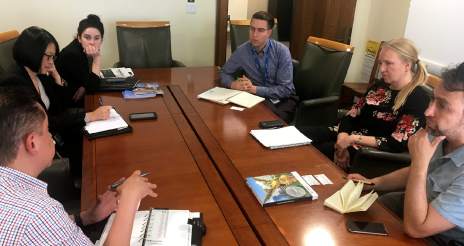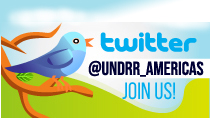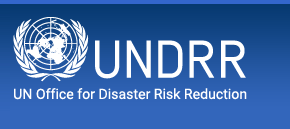- Our Mandate
- Mission and Objectives
- UNDRR in the UN
- Work Programme & Annual Reports
- Results Based System
- Work Partnerships
- Headquarters - Geneva
- SG-UN representatives for DRR
- Regional Office – The Americas and the Caribbean
- Head of the Regional Office – The Americas and the Caribbean
- What is Disaster Risk Reduction?
- What is the International Strategy?
- History of UNDRR
Los Angeles and Mexico City engage with UNDRR in multi-stakeholder, multi-hazard city-to-city exchange
 Roberto Jarramillo Moreno, Director of Relationships of C5 CDMX, speaks about sustainable and resilient public transportation with members of the Los Angeles' Department of Transportation and Marissa Aho and Arnoldo Mathus Kramer, Chief Resilience Officers from Los Angeles and Mexico City, respectively at Rockefeller Foundation's 100 Resilient Cities platform. Photo Credit: Dr. Alexander Mirescu/Advocate UNDRR Making Cities Resilient Campaign
Roberto Jarramillo Moreno, Director of Relationships of C5 CDMX, speaks about sustainable and resilient public transportation with members of the Los Angeles' Department of Transportation and Marissa Aho and Arnoldo Mathus Kramer, Chief Resilience Officers from Los Angeles and Mexico City, respectively at Rockefeller Foundation's 100 Resilient Cities platform. Photo Credit: Dr. Alexander Mirescu/Advocate UNDRR Making Cities Resilient Campaign
By: Dr. Alexander Mirescu
Edited by: UNDRR – The Americas
LOS ANGELES, United States, 03 March 2018 – This past January, UNDRR facilitated a three-day City-to-City exchange between Los Angeles and Mexico City, bringing together the 100 Resilient Cities chief resilience officers (CROs) from both cities, a type of collaboration encouraged by the Sendai Framework for Disaster Risk Reduction 2015-2030 to increase the "understanding of disaster risk" at a global level.
Marrisa Aho of the Los Angeles Mayor's Office organized the exchange. Both cities are prone to earthquakes, on 19 September 2017, Mexico City and surrounding municipalities were devastated by a 7.1 Mw earthquake. In the months since, new vulnerabilities have been exposed, as well as new opportunities to learn from other cities similar in size and with similar risk profiles. On the other hand, Southern California experienced the powerful Northridge earthquake in 1994, which measured 6.7 on the Richter scale.
The United States Geological Society (USGS) at California Institute of Technology opened the first round of discussions. USGS researchers shared their work on seismic, landslide and volcanic risk, as well as early warning technologies and regional information sharing networks between Natural Resources Canada, USGS and their Mexican counterparts.
Kenneth Hudnut, USGS Science Advisor for Risk Reduction, opened the session stressing the necessity to improve knowledge and information transfer for earthquakes and tsunamis between Mexico and the United States. According to Hudnut, "risk does not respect borders, therefore we need to be able to better share early warning information with Tijuana, Mexicali and the greater US-Mexican border region."
Doug Given, another USGS member, presented his research on app-based preparedness and public awareness with Roberto Jarramillo Moreno, Director at Mexico City's Emergency Management Services. USGS and Aho highlighted Los Angeles' public awareness campaign, "Drop, Cover and Hold," as a possible mechanism to improve seismic preparedness in Mexico.
The exchange shifted gears from academia to civil society. Dr. Lucy Jones and Kate Long from the Dr. Lucy Jones Center for Science and Society received workshop participants for a discussion about connecting science with society and policy. "The Southern California Association of Governments (SCAG) seeks to highlight important interdependencies for seismic safety, so as to get [resilient] legislation to council within 12 months," said Dr. Jones. With over 190 municipalities across six counties, forest fire, flood, landslide, tsunami and seismicity all mirror some of Mexico City's risk profile. Moreover, CRO Arnoldo Mathus Kramer articulated the challenges of a regional approach to risk reduction with the dozens of municipalities located in the State of Mexico and neighboring states.
In alignment with the Sendai Framework for Disaster Risk Reduction 2015-2030, Aram Sakanian, General Manager of the Emergency Management Department, emphasized that resilience must include community-based approaches and sustainability. While recognizing that the recovery process is given more attention, Sakanian stated that: "resources and focus need to be allocated for reducing risk through preparedness and prevention."
In addition, Sakanian pointed to the inclusion of many municipal stakeholders and community actors in preparedness, but also spoke of the need to create "resilience survival hubs," strategically located and active distribution, supply chain and assistance centers that play a year-round role in "keeping resilience visible on a day-to-day basis."
Dr. Craig David, Resilience Program Manager at the Department of Water and Power, held an impactful presentation about Los Angeles' future problems and current strategies for making its water infrastructure more resilient to hazards beyond seismicity, such as drought and fire suppression.
Former Ambassador to ASEAN and current Deputy-Mayor of Los Angeles, Nina Hachigian, welcomed the delegates from Mexico City in the Office of Mayor to discuss the city's commitment the Sustainable Development Goals (SDGs) and how cities can it achieve multi-hazard resilience.
The workshop concluded with an identification of some common challenges to be address in the follow-up exchange scheduled to take place in March in Mexico City. Early warning systems remain a challenging area that requires technological attention. Resilient recovery efforts between megacities are another topic for more exchange and knowledge transfer.
The workshop was organized in harmony with the first priority of the Sendai Framework for Disaster Risk Reduction 2015-2030 "Understanding Disaster Risk" which states that in order to do so it is important to enhance the collaboration among people at the local level to disseminate disaster risk information through the involvement of community-based organizations and nongovernmental organizations.
Related Links:
Rockefeller Foundation's 100 Resilient Cities
Follow the UNDRR news online :
 Now we have twitter account @UNDRR Américas y el Caribe
Now we have twitter account @UNDRR Américas y el Caribe
JOIN US!
Tweets por el @UNDRR Américas y el Caribe
